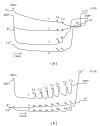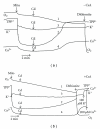Mechanism(s) of Toxic Action of Zn and Selenite: A Study on AS-30D Hepatoma Cells and Isolated Mitochondria
- PMID: 21860797
- PMCID: PMC3154521
- DOI: 10.1155/2011/387297
Mechanism(s) of Toxic Action of Zn and Selenite: A Study on AS-30D Hepatoma Cells and Isolated Mitochondria
Abstract
Mitochondria of AS-30D rat ascites hepatoma cells are found to be the main target for Zn(2+) and sodium selenite (Na(2)SeO(3)). High [mu]M concentrations of Zn(2+) or selenite were strongly cytotoxic, killing the AS-30D cells by both apoptotic and necrotic ways. Both Zn(2+) and selenite produced strong changes in intracellular generation of reactive oxygen species (ROS) and the mitochondrial dysfunction via the mitochondrial electron transport chain (mtETC) disturbance, the membrane potential dissipation, and the mitochondrial permeability transition pore opening. The significant distinctions in toxic action of Zn(2+) and selenite on AS-30D cells were found. Selenite induced a much higher intracellular ROS level (the early event) compared to Zn(2+) but a lower membrane potential loss and a lower decrease of the uncoupled respiration rate of the cells, whereas the mtETC disturbance was the early and critical event in the mechanism of Zn(2+) cytotoxicity. Sequences of events manifested in the mitochondrial dysfunction produced by the metal/metalloid under test are compared with those obtained earlier for Cd(2+), Hg(2+), and Cu(2+) on the same model system.
Figures








Similar articles
-
Respiratory complex II in mitochondrial dysfunction-mediated cytotoxicity: Insight from cadmium.J Trace Elem Med Biol. 2018 Dec;50:80-92. doi: 10.1016/j.jtemb.2018.06.009. Epub 2018 Jun 15. J Trace Elem Med Biol. 2018. PMID: 30262321
-
[ACTION OF MODULATORS OF LARGE-CONDUCTANCE Ca2+-ACTIVATED K+ CHANNELS ON RAT ASCITES HEPATOMA CELLS AND ISOLATED RAT LIVER MITOCHONDRIA TREATED BY Cd2+].Zh Evol Biokhim Fiziol. 2015 Jul-Aug;51(4):225-35. Zh Evol Biokhim Fiziol. 2015. PMID: 26547946 Russian.
-
Mitochondria as an important target in heavy metal toxicity in rat hepatoma AS-30D cells.Toxicol Appl Pharmacol. 2008 Aug 15;231(1):34-42. doi: 10.1016/j.taap.2008.03.017. Epub 2008 Apr 7. Toxicol Appl Pharmacol. 2008. PMID: 18501399
-
Mitigating effect of paxilline against injury produced by Cd2+ in rat pheochromocytoma PC12 and ascites hepatoma AS-30D cells.Ecotoxicol Environ Saf. 2020 Jun 15;196:110519. doi: 10.1016/j.ecoenv.2020.110519. Epub 2020 Apr 1. Ecotoxicol Environ Saf. 2020. PMID: 32244116
-
Mitochondrial dysfunction in the pathogenesis of necrotic and apoptotic cell death.J Bioenerg Biomembr. 1999 Aug;31(4):305-19. doi: 10.1023/a:1005419617371. J Bioenerg Biomembr. 1999. PMID: 10665521 Review.
Cited by
-
Cerebrospinal fluid of newly diagnosed amyotrophic lateral sclerosis patients exhibits abnormal levels of selenium species including elevated selenite.Neurotoxicology. 2013 Sep;38:25-32. doi: 10.1016/j.neuro.2013.05.016. Epub 2013 May 31. Neurotoxicology. 2013. PMID: 23732511 Free PMC article.
References
-
- Beyersmann D, Haase H. Functions of zinc in signaling, proliferation and differentiation of mammalian cells. BioMetals. 2001;14(3-4):331–341. - PubMed
-
- Combs GF. Selenium in global food systems. British Journal of Nutrition. 2001;85(5):517–547. - PubMed
-
- Formigari A, Irato P, Santon A. Zinc, antioxidant systems and metallothionein in metal mediated-apoptosis: biochemical and cytochemical aspects. Comparative Biochemistry and Physiology. 2007;146(4):443–459. - PubMed
-
- Rigobello MP, Bindoli A. Mitochondrial thioredoxin reductase purification, inhibitor studies, and role in cell signaling. Methods in Enzymology. 2009;474:109–122. - PubMed
-
- Spallholz JE. On the nature of selenium toxicity and carcinostatic activity. Free Radical Biology and Medicine. 1994;17(1):45–64. - PubMed
LinkOut - more resources
Full Text Sources
Other Literature Sources
Research Materials

